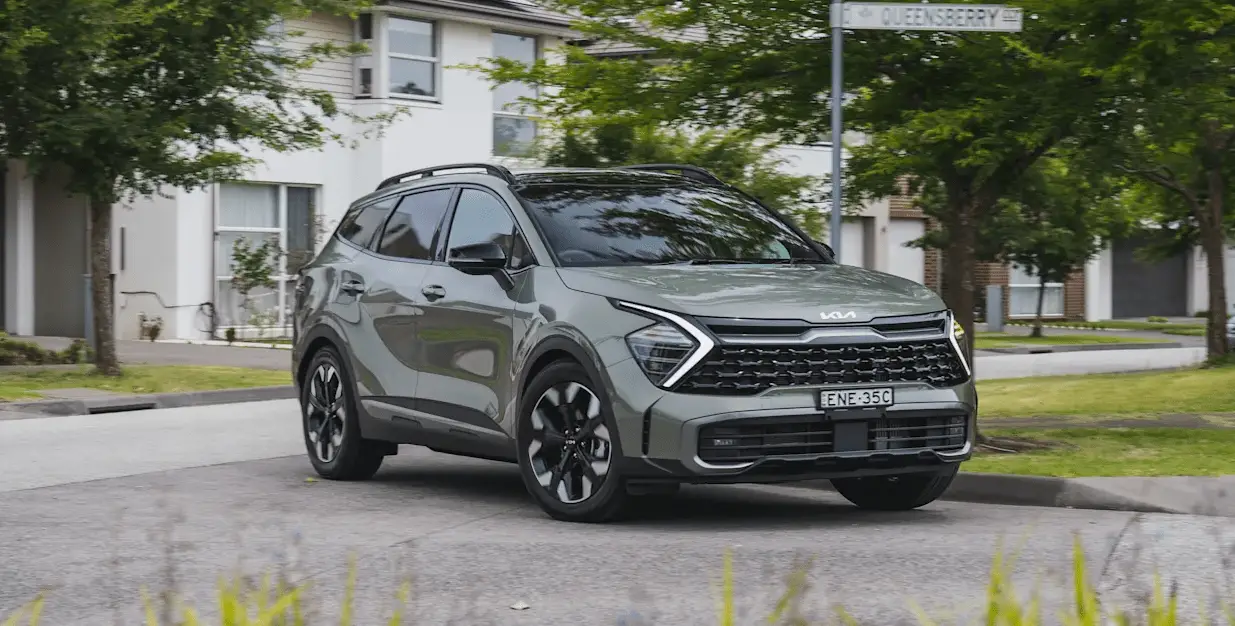Kia Sportage 2022 Automatic Transmission and All-Wheel Drive (AWD)
The Kia Sportage 2022 is a compact SUV that delivers a mix of style, performance, and utility. It is available in two powertrain options: a 2.4-liter 4-cylinder engine generating 181 horsepower and 175 lb-ft of torque, and a turbocharged 2.5-liter 4-cylinder engine generating 237 horsepower and 260 lb-ft of torque. Both engine options are paired with an 8-speed automatic transmission that ensures smooth and efficient gear shifts. The Sportage is also equipped with an optional all-wheel drive (AWD) system, which can enhance traction and handling on rough terrains and in difficult weather conditions. The AWD system can automatically transfer power between the front and rear wheels to optimize stability and traction. In summary, the Kia Sportage 2022 provides a responsive and versatile driving experience with the combination of automatic transmission and AWD.
2023 KIA SPORTAGE Specs, Price, Features and Mileage (Brochure)
Automatic transmission
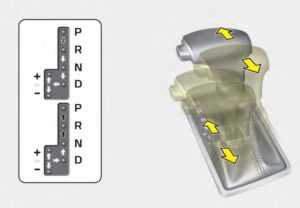
- Depress the brake pedal and the lock release button when shifting.
- Press the lock release button when shifting.
- The shift lever can be shifted freely
Automatic transmission operation
The automatic transmission has 6 forward speeds and one reverse speed. The individual speeds are selected automatically, depending on the position of the shift lever.
NOTICE
The first few shifts on a new vehicle, if the battery has been disconnected, may be somewhat abrupt. This is a normal condition, and the shifting sequence will adjust after shifts are cycled a few times by the TCM (Transmission Control Module) or PCM (Powertrain Control Module). For smooth operation, depress the brake pedal and the lock release button when shifting from N (Neutral) to a forward or reverse gear.
Leaving Vehicle
Before leaving the driver’s seat, always make sure the shift lever is in the P (Park) position; then set the parking brake fully and shut the engine off. Do not use the P position in place of the parking brake. Always make sure the shift lever is locked in the P position and set the parking brake fully. Unexpected and sudden vehicle movement can occur if these precautions are not followed.
Transmission
To avoid damage to your transmission, do not accelerate the engine in R (Reverse) or any forward gear position with the brakes on. The transmission may be damaged if you shift into P (Park) while the vehicle is in motion. When stopped on an incline, do not hold the vehicle with the engine power. Use the service brake or the parking brake.
Transmission ranges
The indicator in the instrument cluster displays the shift lever position when the ignition switch is in the ON position.
P (Park)
Always come to a complete stop before shifting into P (Park). This position locks the transmission and prevents the drive wheels from rotating. Shifting into P (Park) while the vehicle is in motion will cause the drive wheels to lock which will cause you to lose control of the vehicle.
R (Reverse)
Use this position to drive the vehicle backward.
Shifting
Always come to a complete stop before shifting into or out of R (Reverse); you may damage the transmission if you shift into R (Reverse) while the vehicle is in motion, except when “Rocking the vehicle” explained in this chapter.
WARNING
ALWAYS check the surrounding areas near your vehicle for people, especially children, before shifting a vehicle into D (Drive) or R (Reverse).
N (Neutral)
The wheels and transmission are not engaged. The vehicle will roll freely even on the slightest incline unless the parking brake or service brakes are applied.
- Parking in N (Neutral) gear
Follow the below steps when parking and you want the vehicle to move when pushed.
- After parking your vehicle, depress the brake pedal and move the shift lever to [P] with the ignition button in [ON] or while the engine is running.
- If the parking brake is applied unlock the parking brake.
- For EPB (Electronic Parking Brake) equipped vehicles, push the brake pedal with the ignition button in [ON] or while the engine is running to disengage the parking brake. If the [AUTO HOLD] function is used while driving (If the [AUTO HOLD] indicator is on in the cluster), press the [AUTO HOLD] switch and the [AUTO HOLD] function should be turned off.
- While pressing the brake pedal, turn the ignition button [OFF].
- For smart key-equipped vehicles, the ignition switch can be moved to [OFF] only when the shift lever is in [P].
- Change the gear shift lever to [N] (Neutral) while pressing the brake pedal and pushing the [SHIFT LOCK RELEASE] button or inserting, pressing down a tool (e.g. flathead screw-driver) into the [SHIFT LOCK RELEASE] access hole at the same time. Then, the vehicle will move when external force is applied.
Parking In Neutral
With the exception of parking in neutral gear, always park the vehicle in [P] (Park) for safety and apply the parking brake. Before parking in [N] (Neutral) gear, make sure the parking ground is level and flat. Do not park in [N] gear on any slopes or gradients. If parked and left in [N], the vehicle may move and cause serious damage or injury.
D (Drive)
This is the normal forward driving position. The transmission will automatically shift through a 6-gear sequence, providing the best fuel economy and power. For extra power when passing another vehicle or climbing grades, depress the accelerator fully, at which time the transmission will automatically downshift to the next lower gear.
The paddle shifter is available when the shift lever is in the D position or the manual mode.
With the shift lever in the D position
The paddle shifter will operate when the vehicle speed is more than 6.2mph(10km/h). Pull the [+] or [-] paddle shifter once to shift up or down one gear and the system changes from automatic mode to manual mode. When the vehicle speed is lower than 6.2mph(10km/h), if you depress the accelerator pedal for more than 5 seconds or if you shift the shift lever from D (Drive) to manual mode and shift it from manual mode to D (Drive) again, the system changes from manual mode to automatic mode.
With the shift lever in the manual mode
Pull the [+] or [-] paddle shifter once to shift up or down one gear.
NOTICE
If you pull the [+] and [-] paddle shifters at the same time, you cannot shift the gear.
Shift lock system
For your safety, the automatic transmission has a shift lock system that prevents shifting the transmission from P (Park) into R (Reverse) unless the brake pedal is depressed.
To shift the transmission from P (Park) into R (Reverse):
- Depress and hold the brake pedal.
- Start the engine or turn the ignition switch to the ON position.
- Move the shift lever.
- If the brake pedal is repeatedly depressed and released with the shift lever in the P (Park) position, a chattering noise & vibration near the shift lever may be heard. It is a normal condition.
Shifting from park
Always fully depress the brake pedal before and while shifting out of the P (Park) position into another position to avoid inadvertent motion of the vehicle which could injure persons in or around the vehicle.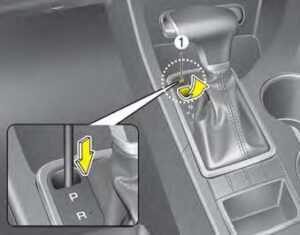
Shift-lock override
If the shift lever cannot be moved from the P (Park) position into R (Reverse) position with the brake pedal depressed, continue depressing the brake, then do the following:
- Place the ignition switch in the LOCK/OFF position.
- Apply the parking brake.
- Carefully remove the cap (1) covering the shift-lock release access hole.
- Insert a tool (e.g. flathead screw-driver) into the access hole and press down on the tool.
- Move the shift lever.
- Remove the tool from the shift lock override access hole then install the cap.
- We recommend that the system be inspected by an authorized Kia dealer.
Ignition key interlock system
The ignition key cannot be removed unless the shift lever is in the P (Park) position. Even if the ignition switch is in the LOCK position, the key cannot be removed. If your vehicle is equipped with an ENGINE START/STOP button, the button will not change to the OFF position unless the shift lever is in the P (Park) position.
Good driving practices
- Never move the gear shift lever from P (Park) to any other position with the accelerator pedal depressed.
- Never move the gear shift lever into P (Park) when the vehicle is in motion.
- Slow down before shifting to a lower gear. Otherwise, the lower gear may not be engaged.
- Always use the parking brake. Do not depend on placing the transmission in P (Park) to keep the vehicle from moving.
- Optimum vehicle performance and economy are obtained by smoothly depressing and releasing the accelerator pedal.
WARNING
When driving uphill or downhill, always shift to D (Drive) for driving forward or shift to R (Reverse) for driving backward, and check the gear position indicated on the cluster before driving. Driving in the opposite direction of the selected gear can lead to a dangerous situation by shutting off the engine and affecting the braking performance.
Kickdown Mechanism
Use the kickdown mechanism for maximum acceleration. Depress the accelerator pedal beyond the pressure point. The automatic transmission will shift to a lower gear depending on the engine speed.
Driving up a steep grade from a standing start
To drive up a steep grade from a standing start, depress the brake pedal, and shift the shift lever to D (Drive). Select the appropriate gear depending on load weight and steepness of the grade, and release the parking brake. Depress the accelerator gradually while releasing the service brakes. When accelerating from a stop on a steep hill, the vehicle may have a tendency to roll backward. Shifting the shift lever into 2 (Second Gear) will help prevent the vehicle from rolling backward.
ALL WHEEL DRIVE (AWD) (IF EQUIPPED)
The All Wheel Drive (AWD) system delivers engine power to the front and rear wheels for maximum traction. AWD is useful when extra traction is required on road, such as, when driving on slippery, muddy such as wet, or snow-covered roads. These vehicles are not designed for challenging off-road use. It is always important when traveling on unpaved roads that the driver carefully reduces the speed to a level that does not exceed the safe operating speed for those conditions. In general, unpaved roads provide less traction and braking effectiveness than normal road conditions.
* AWD: All Wheel Drive
FWD: Front Wheel Drive
The driver must be especially alert to avoid driving on slopes that tilt the vehicle to either side.
Off-road driving
Do not attempt to operate your vehicle under extreme or challenging off-road driving conditions. This vehicle was not designed to be driven off-road.
NOTICE
If the AWD system warning light ( ) illuminates, this indicates that there is a malfunction in the AWD system. If this occurs, we recommend that the system be checked by an authorized Kia dealer.
Tight corner brake effect
AWD
When turning sharply on a paved road at low speed while in all-wheel drive, steering control will be difficult. The tight corner brake effect is a unique characteristic of all-wheel drive vehicles caused by the difference in tire rotation at the four wheels and the zero-degree alignment of the front wheels and suspension. Sharp turns at low speeds should be carried out with caution.
All Wheel Drive (AWD) transfer mode selection
| Transfer mode | Selection button | Indicator light | Description |
| AWD AUTO
(AWD LOCK is deactivated) |
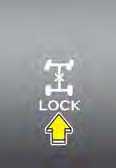 |
(Indicator light is not illuminated) | • When driving in AWD AUTO mode, the vehicle operates similar to conventional FWD vehicles under normal operating conditions. However, if the system determines that there is a need for the AWD mode, the engine’s driving power is distributed to all four wheels automatically without driver intervention.
• When driving on normal roads and pavement, the vehicle moves similar to conventional FWD vehicles. |
| AWD LOCK |  |
(Indicator light is illuminated) | • This mode is used for climbing or descending sharp grades, off-road driving, driving on sandy and muddy roads, etc., to maximize traction.
• This mode automatically begins to deactivate at speeds above 38 mph (60 km/h) and is shifted to AWD AUTO mode at speed above 38 mph (60 km/h). If the vehicle decelerates to speeds below 38 mph (60 km/h), however, the transfer mode is shifted into AWD LOCK mode again. |
NOTICE
When driving on normal roads, deactivate the AWD LOCK mode by pushing the AWD LOCK button (the indicator light goes off). Driving on normal roads with AWD LOCK mode(especially, when cornering) may cause mechanical noise or vibration. The noise and vibration will disappear when the AWD LOCK mode is deactivated. Some parts of the power train may be damaged by prolonged driving with noise and vibration. When the AWD LOCK mode is deactivated, a shock may be felt as the drive power is delivered entirely to the front wheels. This shock is not a mechanical failure.
For safe all-wheel drive operation
All wheel drive
The road conditions that demand all-wheel drive mean all functions of your vehicle are exposed to extreme stress than under normal road conditions. Slow down and be ready for changes in the composition and traction of the surface under your tires. If you have any doubt about the safety of the conditions you are facing, stop and consider the best way to proceed. Do not exceed the ability of yourself or your vehicle to operate safely. Do not try to drive in deep-standing water or mud since such conditions can stall your engine and clog your exhaust pipes. Do not drive down steep hills since it requires extreme skill to maintain control of the vehicle.
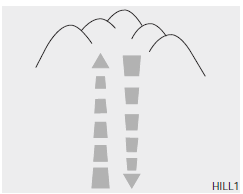
- When you are driving up or down hills drive as straight as possible. Use extreme caution in going up or down steep hills, since you may flip your vehicle over depending on the grade, terrain and water/mud conditions.
 Hills
Hills
Driving across the contour of steep hills can be extremely dangerous. This danger can come from slight changes in the wheel angle which can destabilize the vehicle or, even if the vehicle is maintaining stability under power, it can lose that stability if the vehicle stops its forward motion. Your vehicle may roll over without warning and without time for you to correct a mistake that could cause serious injury or death. You must consciously make the effort to learn how to corner in an AWD vehicle. Do not rely on your experience in conventional FWD vehicles in choosing safe cornering speed in AWD mode. For starters, you must drive more slowly in AWD. Drive carefully when driving on unpaved roads because your vehicle may be damaged by rocks or roots of trees.
AWD
Reduce speed when you turn corners. The center of gravity of AWD vehicles is higher than that of conventional FWD vehicles, making them more likely to roll over when you turn corners too fast.
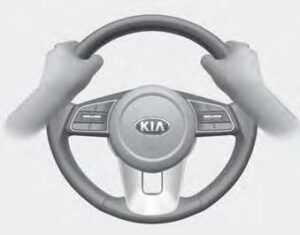
Steering wheel
Do not grab the inside of the steering wheel when you are driving off-road. You may hurt your arm by a sudden steering maneuver or from a steering wheel rebound due to impact with objects on the ground. You could also lose control of your steering wheel while driving on rough terrain.
- Always hold the steering wheel firmly when you are driving off-road.
- Make sure all passengers are wearing seat belts.
Wind danger
If you are driving in heavy wind, the vehicle’s higher center of gravity decreases your steering control capacity and requires you to drive more slowly. If you need to drive in the water, stop your vehicle, set your transfer to the AWD LOCK mode, and drive at less than 5 mph (8 km/h).
Driving through water
Drive slowly. If you are driving too fast in water, the water can get into the engine compartment and wet the ignition system, causing your vehicle to suddenly stop. If this happens and your vehicle is in a tilted position, your vehicle may roll over.
NOTICE
- Do not drive in water if the level is higher than the bottom of the vehicle.
Check your brake condition once you are out of mud or water. Press the brake pedal several times as you move slowly until you feel normal braking forces return. - Shorten your scheduled maintenance interval if you drive in off-road conditions such as sand, mud, or water (see “Maintenance under severe usage conditions” in section 8). Always wash your vehicle thoroughly after off-road use, especially cleaning the bottom of the vehicle.
- Since the driving torque is always applied to the 4 wheels the performance of the AWD vehicle is greatly affected by the condition of the tires. Be sure to equip the vehicle with four tires of the same size and type.
- A full-time all-wheel drive vehicle cannot be towed by an ordinary tow truck. Make sure that the vehicle is placed on a flatbed truck for moving.
AWD driving
- Avoid high cornering speed.
- Do not make quick steering wheel movements, such as sharp lane changes or fast, sharp turns.
- The risk of rollover is greatly increased if you lose control of your vehicle at high speed.
- Loss of control often occurs if two or more wheels drop off the roadway and the driver over-steers to re-enter the roadway. In the event your vehicle leaves the roadway, do not steer sharply. Instead, slow down before pulling back into the travel lanes.
Mud or snow
If one of the front or rear wheels begins to spin in mud, snow, etc. the vehicle can sometimes be driven out by depressing the accelerator pedal further; however, do not run the engine continuously at high RPMs to free the vehicle from snow or mud because doing so could dam-age the AWD system
Reducing the risk of a rollover
This multi-purpose passenger vehicle is defined as a Sports Utility Vehicle (SUV). SUVs have higher ground clearance and a narrower track to make them capable of performing in a wide variety of off-road applications. Specific design characteristics give them a higher center of gravity than ordinary vehicles. An advantage of the higher ground clearance is a better view of the road, which allows you to anticipate problems. They are not designed for cornering at the same speeds as conventional passenger vehicles, any more than low-slung sports vehicles are designed to perform satisfactorily in off-road conditions. There are steps that a driver can take to reduce the risk of a rollover. If at all possible, avoid sharp turns or abrupt maneuvers, do not load your roof rack with heavy cargo, and never modify your vehicle in any way.
Replacement tires
Always use the size and type of tires recommended in the tire section of the manual. Installation of variant tires can affect the safety and performance of your vehicle.
Jacked vehicle
While the full-time AWD vehicle is being raised on a jack, never start the engine or cause the tires to rotate. There is the danger that rotating tires touching the ground could cause the vehicle to go off the jack and to jump forward. Full-time AWD vehicles must be tested on a special four-wheel chassis dynamometer.
NOTICE
Never engage the parking brake while performing these tests. A full-time AWD vehicle should not be tested on an FWD roll tester. If an FWD roll tester must be used, perform the following:

- Check the tire pressures recommended for your vehicle.
- Place the front wheels on the roll tester for a speedometer test as shown in the illustration.
- Release the parking brake.
- Place the rear wheels on the temporary free roller as shown in the illustration.
Dynamometer testing
Keep away from the front of the vehicle while the vehicle is in gear on the dynamometer. This is very dangerous as the vehicle can jump forward and cause serious injury or death.
NOTICE
When lifting up the vehicle, do not operate the front and rear wheels separately. All four wheels should be operated.
NOTICE
If you need to operate the front wheel and rear wheel when lifting up the vehicle, you should release the parking brake.
FAQ
What are the available powertrains for the Kia Sportage 2022?
The Kia Sportage 2022 comes with two available powertrains: a 2.4-liter 4-cylinder engine with 181 horsepower and 175 lb-ft of torque, and a turbocharged 2.5-liter 4-cylinder engine with 237 horsepower and 260
lb-ft of torque.
What type of transmission does the Kia Sportage 2022 come with?
Both engines are paired with an 8-speed automatic transmission that provides smooth and efficient shifts.
What is the benefit of having an automatic transmission on the Kia Sportage 2022?
The automatic transmission on the Kia Sportage 2022 provides smooth and efficient shifts, making for a comfortable driving experience.
What is all-wheel drive (AWD)?
All-wheel drive (AWD) is a drivetrain system that can provide improved traction and handling in challenging weather conditions or on rough terrain.
Is AWD an option on the Kia Sportage 2022?
Yes, the Sportage offers all-wheel drive (AWD) as an option.
How does the AWD system work on the Kia Sportage 2022?
The AWD system on the Kia Sportage 2022 can automatically transfer power between the front and rear wheels to maximize traction and stability.
Does the AWD system on the Kia Sportage 2022 provide improved performance?
Yes, the AWD system can provide improved traction and handling, which can result in improved performance on challenging roads or rough terrain.
Is the AWD system on the Kia Sportage 2022 always on?
No, the AWD system on the Kia Sportage 2022 is not always on. It is designed to engage automatically when needed.
Can the driver control the AWD system on the Kia Sportage 2022?
No, the AWD system on the Kia Sportage 2022 is automatic and cannot be controlled by the driver.
What is the benefit of having AWD on a vehicle?
The benefit of having AWD on a vehicle is improved traction and handling in challenging weather conditions or on rough terrain.
Can the AWD system on the Kia Sportage 2022 be turned off?
No, the AWD system on the Kia Sportage 2022 cannot be turned off. It is designed to engage automatically when needed.
Does the Kia Sportage 2022 come with other driving modes?
Yes, the Kia Sportage 2022 comes with other driving modes, including Eco, Normal, Sport, and Custom.
Can the driver choose between different driving modes on the Kia Sportage 2022?
Yes, the driver can choose between different driving modes on the Kia Sportage 2022.
What is the benefit of having different driving modes on the Kia Sportage 2022?
The benefit of having different driving modes on the Kia Sportage 2022 is that the driver can customize the driving experience to their preferences, whether they want a more fuel-efficient drive or a more sporty and responsive drive.
What other features does the Kia Sportage 2022 come with?
The Kia Sportage 2022 comes with a variety of features, including a touchscreen infotainment system with Apple CarPlay and Android Auto compatibility, a rearview camera, blind spot detection, and lane departure warning.
Useful Links
View Full User Guide: Kia Sportage 2022 User Guide
Download Manuals: https://owners.kia.com/content/owners/en/manuals.htm
2023 KIA SPORTAGE Specs, Price, Features and Mileage (Brochure)

